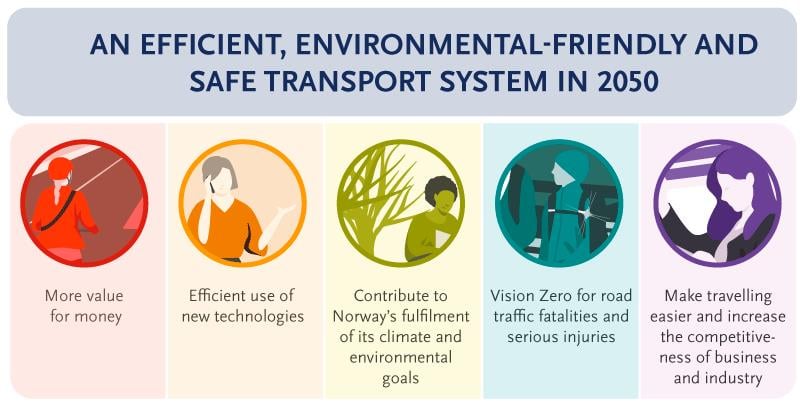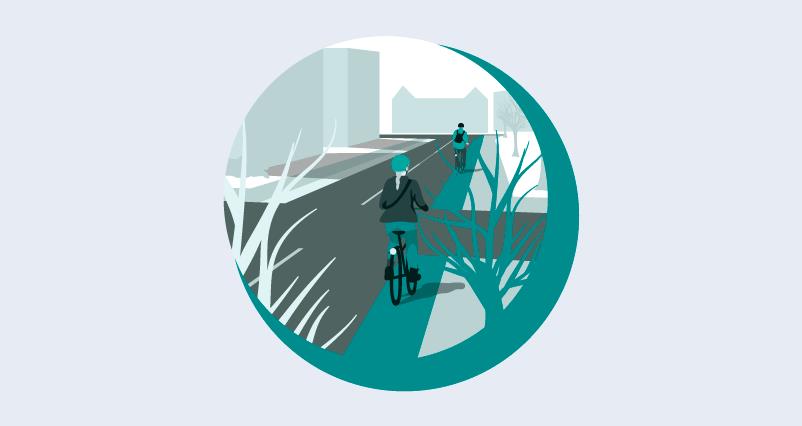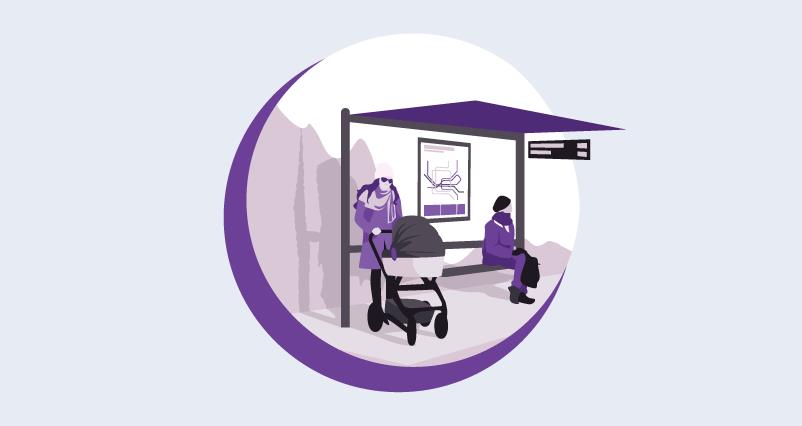5 Initiatives relating to the five policy objectives for an efficient, environmental-friendly and safe transport system in 2050
An efficient, environmental-friendly and safe transport system in 2050 is the overarching, long-term policy objective for the transport sector. Five equally important policy objectives have been developed for the use of resources during the plan period. The objectives are presented in Figure 5.1.

Figure 5.1 The policy objectives for the transport sector
The global Sustainable Development Goals have inspired the overarching objective for the transport plan. The transport plan and its follow-up will have a positive effect on Norway’s possibility of achieving several of the Sustainable Development Goals by 2030.
5.1 We will achieve better results from public spending (“value for money”)

Figure 5.2 Value for money
The ambitions for the transport plan have never been higher, and it is important that the large amounts invested are used efficiently. The work on the plan has therefore been permeated by the goal of getting value for money. Furthermore, investments in transport can benefit from associated value chains when projects are implemented.
The Government has implemented several reforms to enable the transport agencies to utilise the resources allocated to the sector more efficiently. One example is the establishment of Nye Veier. It has been given extensive autonomy to manage the development of its projects, including through portfolio management. This model has led to reduced costs and society getting more value for money. All the agencies will continue their endeavours to optimise projects, and, with this plan, we are implementing portfolio management of investments, so that the agencies themselves can recommend the scope and order of projects. We will also start using elements from the Nye Veier model to achieve more efficient development of railway infrastructure.
By introducing portfolio management, the Government is changing the dynamic of the Norwegian transport sector – from competition for a project to be included in the National Transport Plan to competition to develop the best projects. At the same time, this means that the scope and order of the projects presented in the white paper are not necessarily final. The project overview as presented in the white paper shows the priorities as defined at present. The agencies will continue to optimise, and changes may occur that affect priorities. The agencies will also cooperate with business and industry where this may improve projects. We will therefore facilitate earlier involvement from the building and construction industry, and further development of procurement and contract strategies, also for operation and maintenance.
Cost-/benefit analyses have been an important part of the basis for assessing the priorities in this plan. Addressing the most important challenges first also entails assessing what we believe to be the important considerations when further developing the transport system in the entire country. A solid base for decision-making in the transport sector will therefore be important, including managing uncertainty. As a result of further optimisation and portfolio management, the implementation of the transport plan could result in greater socio-economic profitability than has been the case so far.
The Government aims to:
- continue to realise the gains from the transport sector reforms
- prioritise on the basis of the challenges we want to address, and not commit to detailed projects
- introduce portfolio management in the transport sector, whereby continuous optimisation, competition, learning and more coherent development will help us to choose the best solutions and achieve value for money
- further develop the cost-benefit analyses and other basis for decision-making to ensure coherent, sustainable and long-term strategic planning
- utilise the potential of business and industry to create forward-looking solutions, such as facilitating earlier involvement and smart use of procurement and contract strategies.
5.2 We will use new technologies and research to obtain more efficient and safe transport with lower emissions

Figure 5.3 Use new technologies
New technologies offer better solutions to some of the challenges we have previously addressed through traditional approaches for improving accessibility, capacity and transport safety. Automation, electrification and zero-emission mobility, new business models and the development of intelligent transport systems are some of the drivers in the smart and green transition of the transport sector.
The National Transport Plan 2022–2033 provides for substantially stronger efforts in developing and implementing new technologies in the transport sector. Research, development, piloting and innovation are important elements in this strategy. Through the development of innovation-friendly rules and regulations, we will facilitate the development of new technologies and contribute to mobility solutions and services that will help us achieve the objectives for the transport sector.
The Government aims to:
- use the portfolio management system to enable and provide incentives for continuous optimisation of investments, in line with the pace of the technological development
- cater for the appropriate development, implementation and operation of the digital solutions that sustain the functionning of the transport systems
- ensure robust and updated regulations, including the use of regulatory sandboxing in areas that are considered technologically promising, and actively seek to influence European and international regulatory development
- actively use public procurement and other broad measures to promote technological development
- follow closely technological trends internationally through continuous knowledge-collection, carrying out of technological pilot projects and participate in international co-operation
- facilitate more and better utilisation of the growing amounts of data generated in the transport sector, as a basis for better planning, traffic management and a number of other applications
- make Norway an attractive test-bed for testing new technological solutions, including autonomous and low-emission means of transport in all modes
- facilitate research, development and piloting, both in the transport agencies and through instruments administered by the national R&D agencies, in accordance with technology-related EU research in Horizon Europe
- promote constructive triangular co-operation between transport authorities, research institutions and private industry and business, with a view to enable Norwegian business and industry to develop smarter mobility solutions
- develop a knowledge strategy that can offer an overview of the main challenges in the transport sector and set out a strategic direction for national R&D in the transport sector.
5.3 We will develop a transport sector that contributes to the achievement of Norway’s climate and environmental goals

Figure 5.4 A transport sector that helps to achieve Norway’s climate and environmental goals
The transport sector accounts for almost a third of Norway’s greenhouse gas emissions. The Government’s Report No 13 to the Storting (2020–2021) Klimaplan for 2021–2030 (‘Climate Action Plan for 2021–2030’) was presented in January 2021 as a White Paper. The Climate Action Plan describes how Norway will achieve its ambitious climate goals. The Government’s climate policy for the transport sector is described in detail in the Climate Action Plan. The plan shows that, unless we intensify our use of policy instruments, there will be an emissions gap by 2030. Among the key policy instruments implemented to cut emissions from the transport sector are carbon tax, biofuel quota obligations, different requirements for the use of zero and low-emission technology and investment support schemes. The EU Emissions Trading System is the main policy instrument for the aviation industry. The policy targets for new zero-emission vehicles from the National Transport Plan 2018–2029 remain unchanged, and form the basis for the policy instruments in the Climate Action Plan. The overall emission cuts outlined in the Climate Action Plan mean that we are on course to reduce transport sector emissions by 50% in 2030 compared with 2005.
The National Transport Plan 2022–2033 will contribute to the ambition to reduce transport sector emissions by 50% by 2030 and contribute to Norway achieving its climate and environmental goals.
The policy targets from the National Transport Plan 2018–2029 remain unchanged:
- all new passenger cars and light vans shall be zero-emission vehicles by 2025
- all new city buses shall be zero-emission vehicles or use biogas by 2025
- by 2030, all new heavier vans, 75 per cent of new long-distance buses and 50 per cent of new lorries shall be zero-emission vehicles
- by 2030, goods distribution in the biggest city centres shall take place with virtually zero emissions.
The targets are based on a prerequisite of improvements in technological maturity.
The Transport Plan also follows up the Government’s Action Plan for Fossil-free Construction sites in the transport sector, which was presented at the same time as the Climate Action Plan. The Government will prioritise the implementation of pilot projects for fossil-free construction sites. Increased carbon tax, biofuel quota obligations, and requirements relating to public procurements are key policy instruments for cutting emissions at construction sites as well.
Coordinated land use and transport planning will ensure efficient land use and facilitate environmental-friendly modes of transport. Combined with the “zero growth” objective in the cities, this will help to reduce emissions. The use of cultivated land shall be assessed separately and reduced in transport systems.
The transport agencies’ measures and activities can have a negative impact on ecosystems, for example in the form of fragmentation, destruction of habitat types, barrier effects, disturbances to bird and animal life, the spreading of harmful alien organisms, reduced water quality and the spread of environmentally harmful chemicals and plastic. To increase knowledge and ensure that encroachments on nature areas are as small as possible, the transport agencies and relevant authorities, including the Norwegian Environment Agency, will plan a pilot project for a no net loss stretch of road. The Sustainable Development Goals and a new global framework for the preservation of biodiversity shall form the basis for the work in the sector.
Within their areas of responsibility and with the resources at their disposal, the agencies shall strengthen their efforts to remove plastic waste and implement preventive measures to reduce plastic waste and microplastics into the environment.
During the plan period, the transport agencies shall follow up their work on reducing noise at its sources.
Climate
The Government aims to:
- use general policy instruments, such as the carbon tax and support schemes, as well as biofuel quota obligations, to reduce emissions from the transport sector
- facilitate the development of zero and low-emission solutions in the transport sector
- continue the efforts to achieve the policy targets that, by 2025, all new passenger cars and light vans shall be zero-emission vehicles and all new city buses shall be zero-emission vehicles or use biogas, and that, by 2030, all new heavier vans, 50 per cent of new lorries and 75 per cent of new long-distance buses shall be zero-emission vehicles
- contribute to ensuring that more people choose climate-friendly modes of transport, such as cycling and public transport
- use public procurements to help ensure that zero and low-emission solutions are developed and introduced in the transport sector
- use regulations such as requirements for zero-emission technology in public procurements and emission standards
- use other policy instruments that are important to reducing emissions in the transport sector, including coordinated planning of land use and transport infrastructure
- follow up the Government’s Action Plan for Fossil-free Construction sites in the transport sector, including prioritising NOK 75 million per year in the first six-year period for pilot projects for fossil-free construction sites in the transport sector
- consider policy instruments aimed at ensuring efficient handling of uncompacted material from construction sites
- consider both land use and transport planning when developing transport projects
- assess the establishment of alternative fuel infrastructure and transport infrastructure in a common context, for example by facilitating charging infrastructure at rest stops
- reduce the total area used for transport projects through reuse and optimisation, and by protecting the most carbon-rich areas
- further develop a method for including direct emissions from construction and land-use in the cost-benefit analyses included in impact assessments, conceptual appraisal and in the basis for other decision-making in transport projects, and, in that regard, consider how this can be implemented in connection with the governance of the different transport project portfolios
- consider more closely the possibility of using the Road Traffic Act Section 7 to establish zero-emissions zones for climate reasons, initially in the form of pilot projects in a few cities. The national road networks shall not be included in zero-emission zones
- endeavour to reduce emissions from the operation and maintenance of transport infrastructure.
The environment
The Government aims to:
- contribute to achieving or maintaining good conditions in the ecosystems, especially the coherent blue-green infrastructure, and take account of natural diversity and water environments when planning, developing, operating and maintaining infrastructure and managing property
- avoid planning transport projects through protection areas and, as far as possible, avoid crossing of and encroachments in protected watercourses. Valuable and vulnerable areas of national interest should not be destroyed use the mitigation hierarchy as the basis for ensuring that damage is avoided to the greatest possible extent before considering the implementation of mitigation measures, rehabilitation measures or ecological offset solutions
- plan a pilot project for a no net loss road with the assistance of the environmental authorities, among others
- reduce salt pollution along the national road network
- test an indicator for natural diversity
- that the transport agencies, within their areas of responsibility and with the resources at their disposal, shall strengthen their efforts to remove plastic waste and implement preventive measures to reduce plastic waste and microplastics into the environment.
- contribute to compliance with the Pollution Regulations’ limit values for local air quality and noise
- contribute to meeting the national targets for local air quality
- help to ensure that the municipalities have sufficient policy instruments in place to comply with limit values and national targets for local air quality.
5.4 We will invigorate efforts for transport safety and the vision of zero road fatalities and serious injuries

Figure 5.5 A vision of zero traffic fatalities and serious injuries
The “vision zero” for a transport system where no one is killed or seriously injured applies to the entire transport sector. Measures to achieve the vision zero will have a positive impact on Sustainable Development Goal 3.6 of halving the number of global deaths and injuries from road traffic accidents.
For several years, we have seen a positive development in road safety, thanks to wide-ranging efforts and close cooperation between authorities, the voluntary sector and others. In 2020, fewer than 100 people died in road traffic accidents for the first time since 1947 (this equals a fatality rate of 18/million). Head-on collisions are still the main challenge on the national road network, whereas run-off-the-road traffic accidents are the most common on the county roads network. The number of bicycle or electric scooter accidents is increasing in the major cities. The Government’s ambition is that the number of fatalities and serious injuries in road traffic shall be reduced to a maximum of 350 by 2030, of which maximum 50 shall be fatalities. This means a reduction of 50 per cent compared with the current numbers. The long-term ambition is that there shall be zero fatalities in road traffic in 2050. The level of ambition is high and requires continued efforts in road safety work.
The safety level in Norwegian aviation is very high, and the Government will endeavour to maintain and develop the efforts in this area. The risk associated with Norwegian rail transport is very low and has been further reduced through systematic work on safety and technical barriers. The current risks are mainly related to the surroundings, such as natural incidents and people’s behaviour on and near rail tracks. There is a generally high marine safety level in Norwegian waters. An increase in ship traffic and other activity in coastal and offshore areas is expected in the period up to 2033, as is increased use of low and zero-emission solutions and automation. Safety measures at sea must be further developed and adapted to this development.
The Government aims to:
- use the vision zero as the basis for transport safety priorities
- continue the efforts to maintain the high safety level in transport by rail, air and sea
- pursue the ambition that the number of fatalities and serious injuries in road traffic shall be reduced to a maximum of 350 by 2030, of which maximum 50 shall be fatalities, and that there shall be zero fatalities in road traffic in 2050
- focus on measures targeting infrastructure, measures for pedestrians and cyclists in urban areas, targeted efforts in relation to high-risk factors and vulnerable road users, measures to reduce accidents involving heavy goods vehicles, and support technological developments that promote safety
- endeavour to ensure that, by 2028, 60 per cent of traffic performance on national roads with a speed limit of 70 km/h or higher takes place on roads with median barriers, and that all national roads with a speed limit of 70 km/h or higher will eventually meet a minimum standard for run-off-the-road accidents
- place particular emphasis on the needs of pedestrians, cyclists, and motorcyclists in the design, construction, operation and maintenance of roads
- ensure that children can be safe in traffic, for instance by securing roads near schools, in local communities and other infrastructure, traffic and mobility training and information campaigns
- earmark NOK 500 million in the initial six-year period for measures that improve road safety for children and young people, including establishing a grant scheme to encourage local efforts for safe roads near schools and in local communities.
5.5 We will make travelling easier and increase the competitiveness of Norwegian business and industry

Figure 5.6 Make travelling easier and increase the competitiveness of Norwegian business and industry
Values are created all over Norway and form the basis for our prosperity. The freedom to travel to work and school or to recreational activities and friends is important for individuals and for the overall welfare in Norway. The transport system contributes to value creation by enabling high labour force participation, good residential and labour market regions, sustainable use of the country’s resources and extensive trade with the rest of the world. The transport system shall be so designed that it helps to ensure that Norway remains a good place to live, regardless of age and functional ability. Universal design is key principle to achieve this.
To provide business and industry with good growth conditions and enable increased competitiveness, and to contribute to well-functioning housing and labour market regions, the Government will prioritise maintenance of existing infrastructure throughout the country. Minor investments in road and rail projects will also result in better utilisation of the infrastructure. The Government has prioritised several major investments that improve transport services in corridors and urban areas, while at the same time achieving a geographical balance between robust regional policy and the need for urban development.
The Government plans to strengthen the county roads network through an earmarked grant scheme. Under the scheme, counties are required to select roads on the basis of two criteria: Expansion of housing and labour market regions, and roads of particular importance for certain industries. Projects for maintenance, renewal and improvement must be prioritised within this framework. The focus on county roads is important for the further development of rural areas.
The main challenges in the major urban areas are poor accessibility and delays in the road network and public transport system. This affects both individuals and the business community. Road traffic is also one of the biggest sources of air pollution and noise in urban areas. The Government continues its efforts to achieve zero growth in passenger traffic by car in the major urban areas – with the goal that greenhouse gas emissions, congestion, air pollution and noise shall be reduced through efficient land use and through ensuring that growth in passenger traffic is carried out by public transport, cycling and walking. This initiative will promote Sustainable Development Goal 11 regarding sustainable cities. The Government will follow up the Urban Growth Agreements for the Oslo area, Bergen area, Trondheim area and Nord-Jæren area. Funds are earmarked to enable renegotiation of these agreements in the long term. Steps will also be taken to facilitate Urban Growth Agreements in five other urban areas: Kristiansand, Buskerudbyen, Grenland, Nedre Glomma and Tromsø.
With this Transport Plan, the Government introduces a focus on good solutions for smaller urban areas as well. To facilitate climate and environmental-friendly urban development and good accessibility, the Government will establish a new grant to strengthen efforts relating to public transport, cycling and walking in smaller urban areas.
As part of the Government’s regional policy objectives, a climate-friendly and efficient transport system is important for small towns and their surrounding areas. These towns are vital hubs for the population and business community in their region, and thereby for the Government’s policy objectives for regional balance.
Norwegian business and industry are spread throughout the country, and a large proportion of the production of raw materials and industrial production takes place in rural areas and along the coast. For many enterprises, the distance from the production site to the market, whether it is domestic or international, is a long one. Sea, road, rail and air transport offer different qualities and advantages that meet different customers’ needs. The Government will focus on socio-economically profitable measures that increase efficiency and reliability, reduce transport times, improve safety, and are climate and environmental-friendly, and will thereby help to strengthen the competitiveness of business and industry.
The Government regards the transport system in North Norway as a means to facilitate regional development and provide new possibilities for the most important industries in the region. Its transport system will be developed in an environmentally sustainable manner, emphasising safety and accessibility for everyone. The economic and social development of this region is a national concern. The rich resource base contributes to economic growth for the whole of Norway.
The Government wants to ensure accessibility and functionality in the transport system, under both normal and extraordinary circumstances. The society in general and the transport sector are rapidly changing, and the sector will face a complex risk, threat and vulnerability situation in the years ahead. The Government will follow up the overarching objectives as they are summarised in the strategy for civil protection in the transport sector, by implementing measures that reduce the risk of undesirable incidents and acts, and their consequences. Climate projections in Norway show that the whole country will experience climate change. The transport sector must be prepared to both prevent and handle larger, more frequent and more severe natural incidents, and climate adaptation is a priority area in the civil protection strategy.
Aviation is changing as a result of the coronavirus pandemic. The drop in demand, overcapacity, a strained financial situation on the part of the actors involved, the airlines’ hunt for new business opportunities and the relative attractiveness of the Norwegian domestic market all contribute to this situation. The Government wants to maintain well-functioning air services.
The Government aims to:
- contribute to the development of housing and labour market regions throughout Norway through development of corridors with shorter travel times and a high degree of reliability
- increase the grants to the county authorities for upgrading the county roads network
- present a separate strategy for strengthening small towns’ and urban areas’ position as regional powerhouses, so that they can contribute to growth, equal living conditions and sustainable development throughout Norway
- contribute to continuous, universally designed travel chains
- give children opportunities to become active and independent transport users
- take the needs of children and young people into account in land use and transport planning
- continue the Urban Growth Agreements scheme to reduce greenhouse gas emissions, congestion, air pollution and noise in urban areas through efficient land use and by ensuring that passenger traffic growth is carried out by public transport, cycling and walking
- follow up the agreements for the Oslo area, Bergen area, Trondheim area and Nord-Jæren, and facilitate renegotiation of the agreements in the longer term
- contribute to the extension of the Bergen Light Rail network to Åsane in Bergen and a new Majorstuen station in Oslo through the Urban Growth Agreements
- take steps to facilitate Urban Growth Agreements also for the Kristiansand region, Buskerudbyen, Grenland, Nedre Glomma and Tromsø
- assess how to follow up the recommendations from the expert committee for revenues urban toll road collection
- establish a new grant scheme for climate and environmental-friendly urban development and accessibility in Bodø, Ålesund, Haugesund, Arendal/Grimstad and Vestfold conurbation (Tønsberg, Sandefjord and Larvik)
- make it a long-term goal that cycling’s share in urban areas shall be around 20 per cent and 8 per cent nationwide
- continue the work on achieving the goal of virtually zero emissions from goods distribution in the largest city centres by 2030
- strengthen freight transport by sea through a separate short sea shipping strategy and national port plan
- strengthen freight transport by road by improving accessibility, regularity, availability and travel times, for instance by continuing planning the national road network for up to 25,25-metre-long modular trucks during the plan period
- increase the capacity, reduce the costs, and improve the regularity and profitability of freight transport by rail, i.e. through capacity-increasing measures on the most important freight lines and rationalisation of timber transport
- cooperate with neighbouring countries on joint development of transport services
- upgrade and further develop the road network in Northern Norway, to facilitate economic development and expand the housing and labour market regions
- improve fairways and access to the ports of Røst, Værøy, Andenes, Årviksand, Kjøllefjord and Vardø
- reduce transport times and increase capacity for rail freight transport
- continue to improve emergency preparedness against acute pollution in the Northern Norway
- ensure accessibility and functionality in the transport system, under both normal and extraordinary circumstances
- strive to achieve a high transport security level and avoid large-scale undesirable incidents that lead to injuries to people, or damage to the environment or material assets, and reduce the consequences of such incidents should they nevertheless occur
- seek to highlight and include civil protection in cost-benefit analyses in connection with transport infrastructure projects
- prioritise implementing the new Security Act in the transport sector
- maintain a systematic overview of the risk and vulnerability situation in the transport sector
- strengthen the regulation and monitoring of digital security in the transport sector, as well as the ability to carry out efficient digital handling of incidents
- further develop the transport sector’s role in Norway’s total defence system and facilitate robust emergency preparedness in the transport sector to be able to maintain necessary transport capacity across the crisis spectrum
- ensure local support for road tolls, a uniform toll rate system and limit cost-increasing special schemes
- ensure that toll rates reflect the socio-economic costs of transport to a greater extent
- take account of technological developments, changed needs and international driving forces for the development of a collection and toll rate system in the future
- consider whether road pricing should be used to a greater extent
- give more emphasis to the impact of road tolls on the profitability of projects, and introduce a socio-economic financing test
- allocate funds to relocate Bodø Airport and build a new airport in Mo i Rana during the initial six-year period
- prioritise the protection of roads susceptible to landslides/rockslides
- implement and follow up a conceptual appraisal report for transport solutions in Northern Norway, including assessments of the need for the Northern Norway Railway line
- ensure good air transport services over time and follow up developments in aviation
- facilitate the aviation industry’s transition to the low-emission society
- continue the work on a strategy for Norwegian aviation.